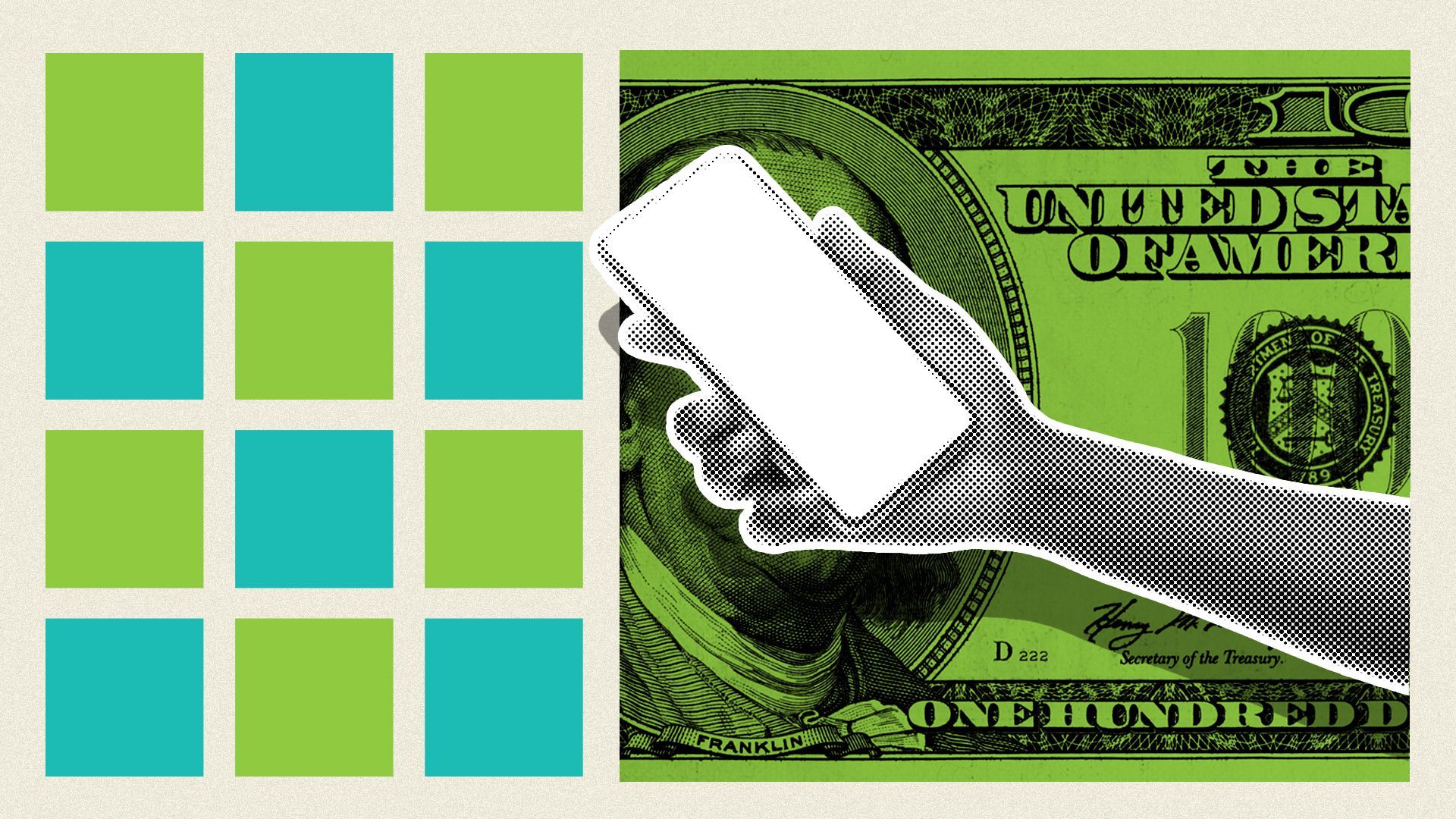| | | | | | | Presented By Latham & Watkins | | | | Axios Pro Rata | | By Kia Kokalitcheva ·Apr 02, 2022 | | Welcome back, readers! - 💰 News: We're launching Axios Crypto! Get a daily digest of all the latest crypto news from Brady Dale (and of course, I'll be making some guest appearances, too). Sign up!
- 🚨 Reminder: Feel free to send me tips or comments by replying to this email or on Twitter @imkialikethecar.
Today's newsletter is 1,194 words, a 4.5-minute read. | | | | | | 1 big thing: Ultra-fast grocery delivery's ambitious math is déjà vu |  | | | Illustration: Sarah Grillo/Axios | | | | It's Groundhog Day — that is, if you're watching the recent boom in ultra-fast grocery delivery services whose success hinges on achieving extraordinarily high order volumes, just like a generation of on-demand services hoped to a few years ago. Why it matters: We're already seeing market consolidation, companies going out of business, and desperation for new cash infusions as the realities of the ultra-fast grocery delivery business model set in. The big picture: Over the past year or so, a number of companies promising to deliver grocery and convenience items in a matter of minutes have cropped up in U.S. cities. Some had already been operating in Europe, too. - The pandemic's restrictions were a boon for all kinds of delivery businesses while people were stuck at home.
Flashback: Several years ago, the popularity of on-demand ride-hailing services such as Uber and Lyft gave rise to a bevy of apps offering other services at a tap of a button. One such genre was the on-demand car parking valet. - Several apps such as Luxe Valet, Zirx, and Carbon vied to provide valet parking on demand to help customers avoid the hassle of looking for parking.
- Their business models depended on having just the right number of valets on duty to keep customer wait times low while ensuring the valets were idle as little as possible — idleness is when these companies would lose money.
- Achieving that proved elusive and the companies all eventually folded.
Today: Ultra-fast delivery companies are claiming they can strategically plant warehouses within a city, allowing both short delivery times for customers and efficiency for couriers. - Again, making every transaction — and the overall business — profitable hinges on dense volumes of clustered orders with high-enough basket sizes.
- And as Vitaly Alexandrov, co-founder of Palo Alto, Calif.-based Food Rocket admitted to me last summer, delivering a single avocado is not a profitable transaction.
- Some of these companies are also hiring couriers as employees instead of independent contractors, to differentiate themselves from gig economy companies and maintain control over their staffing decisions. However, that also comes with higher costs, which makes the businesses even more expensive to operate.
State of play: So far, it's not looking too good for these delivery services. - Some of the smaller ones in NYC recently folded (Fridge No More and Buyk), while Gopuff is reportedly planning layoffs to trim costs, and Berlin-based Gorillas is seeking more cash after raising $1 billion in the fall.
- Companies like Gopuff are hoping that in-app advertising will pad their revenues.
- And as one investor familiar with this category points out, customers are more prone to turn to these services (and pay the fees) when they need a convenience item rather than to do their weekly grocery shopping.
What to watch: The big delivery companies are dipping their toes into the market, putting even more pressure on all competitors. - Last week, grocery delivery company Instacart announced its own quick delivery service. DoorDash did too in December.
- Uber struck a deal with Gopuff last year to feature the latter's items and delivery service within its food delivery service.
The bottom line: Margins in grocery delivery remain very slim. |     | | | | | | 2. Gorillas' fundraising pitch |  | | | Illustration: Aïda Amer/Axios | | | | Gorillas, the Berlin-based delivery company that also operates in a number of other European countries, needs to raise potentially up to $700 million in new cash. - Axios obtained one of the fundraising pitch decks for this Series D round.
By the numbers: - The company says it has more than 700,000 customers and has generated more than $700 million in "run-rate gross transaction value" (which includes gross merchandise volume, delivery fees, tips, and value-added tax).
- Customers generate just over $100 in monthly gross transaction volume after 13 months, up from $69 in their first month.
- It says that 19 of its warehouses are "profitable" (as of January, it had 234 total).
What's next: The company notes that it's currently working on adding new verticals and expanding existing ones — and in the future, it wants to incorporate wearable health tech devices and "AI-driven consumption guidance." |     | | | | | | 3. Another throwback: taxis on ride-hailing apps |  | | | Illustration: Shoshana Gordon/Axios | | | | Just over a week ago, Uber announced it will be integrating taxis into its ride-hailing app in New York City, via partnerships with apps Curb and ARRO — a surprising turn for a company that spent its early years waging war against the U.S. cab industry. Why it matters: While the move may seem surprising, it shouldn't be. George Arison, who co-founded Curb (then called Taxi Magic) back in 2007, tells Axios that Uber (and rival Lyft) have effectively evolved over the years into cab companies. Catch up quick: In NYC, Uber will integrate taxi-hailing into its app and will get a cut of taxi fares that its customers book. - The deal should help both sides: Uber gets more available drivers to service its customers, while the taxis get more ride requests by tapping into Uber's demand.
- Uber already has similar deals elsewhere, including in Colombia, Germany, Austria, and Hong Kong, and is reportedly working on one in San Francisco.
What they're saying: "Nobody in the taxi industry wanted to change … they all thought the regulatory regime would protect them — but it didn't," Arison tells Axios of the cab industry's failure to compete with ride-hailing services when they emerged a decade ago. - When Taxi Magic first got started, the company wanted to create a way for passengers to electronically pay for their cab rides, and was focused on corporate customers taking rides. However, it quickly found out that passengers were more excited about booking the rides with a phone than anything else.
- A string of mistakes, including not building an iPhone app quickly enough, and a failed deal with Lehman Brothers just weeks before it went under, left TaxiMagic behind enough for ride-hailing apps to jump in and enlist people with cars to ferry passengers.
- And while a number of companies over the years have attempted with mixed success to build similar apps for taxis, the industry never truly migrated to the technology that made Uber and Lyft so popular among their passengers.
On the flip side: Uber and Lyft have slowly but surely taken on much of the practices of taxi operators. - The companies are far more regulated in certain markets today than they were at the start. In NYC, among other cities, their drivers are licensed by the local transportation agency and have driver-earning requirements.
- The companies have also dabbled in leasing and renting out cars, though Uber eventually got out of that business, while Lyft has been criticized for aggressive costs and terms for drivers.
The bottom line: "It's because they have to make money," Arison says of Uber's decision to make friends with the industry it used to wage war against. |     | | | | | | A message from Latham & Watkins | | Capitalization tables 101 | | |  | | | | What's in a capitalization table? Everything. Voting rights, economic rights, and the value of your shares if you accept new VC funding. Learn what a cap table should include and see pre and post-Financing examples at LathamDrive. Get started. | | | | | | 📚 Due Diligence | - The Delivery Giants Are Throwing a Pivot Party (Bloomberg)
- Gopuff Plans Hundreds of Layoffs to Cut $40 Million in Costs (The Information)
- Why This Valet Parking Startup Gave Up on Its Uber-Like Service (Fortune)
|     | | | | | | 🧩 Trivia | | Instead of a trivia question this week, enjoy this nine-year-old video clip of my colleague Dan Primack moderating a debate in Brooklyn between Uber co-founder and then-CEO Travis Kalanick and the then-head of NYC's taxi commission. |     | | | | | | 🧮 Final Numbers |  Data: Pitchbook. Chart: Thomas Oide/Axios |     | | | | | | A message from Latham & Watkins | | Incorporating a startup? Here's where to start | | |  | | | | Latham has helped hundreds of founders incorporate their businesses. Now, we've created a free tool that lets you do it yourself — LathamDrive's Document Generator. Keep moving forward — check out LathamDrive's Document Generator today. | | | | 🙏 Thanks for reading! See you on Monday for Pro Rata's weekday programming, and please ask your friends, colleagues, and grocery shoppers to sign up. | | | | | | Axios thanks our partners for supporting our newsletters. If you're interested in advertising, learn more here.
Sponsorship has no influence on editorial content. Axios, 3100 Clarendon Blvd, Suite 1300, Arlington VA 22201 | | | You received this email because you signed up for newsletters from Axios.
Change your preferences or unsubscribe here. | | | Was this email forwarded to you?
Sign up now to get Axios in your inbox. | | | | Follow Axios on social media:    | | | | | |









No comments:
Post a Comment